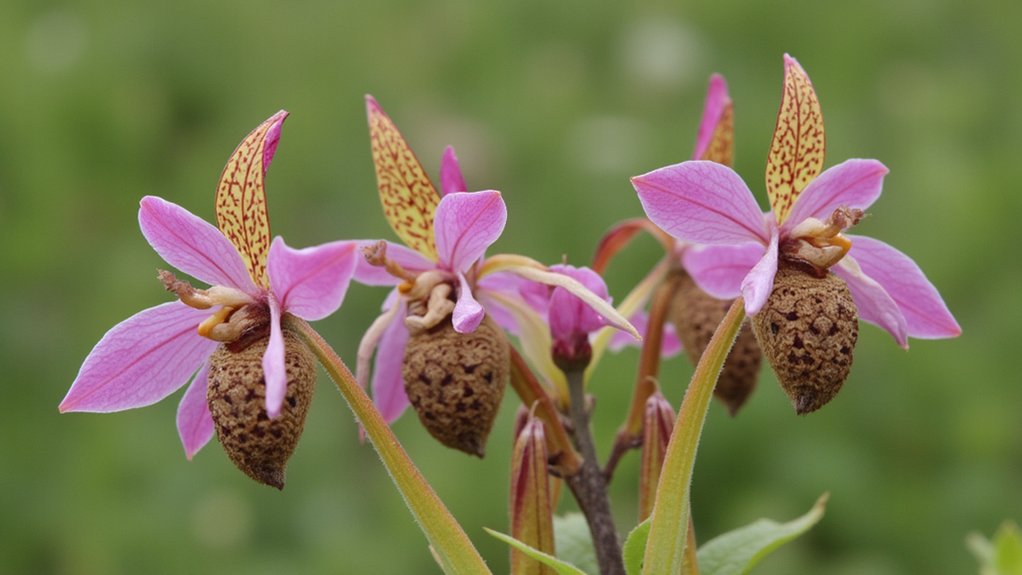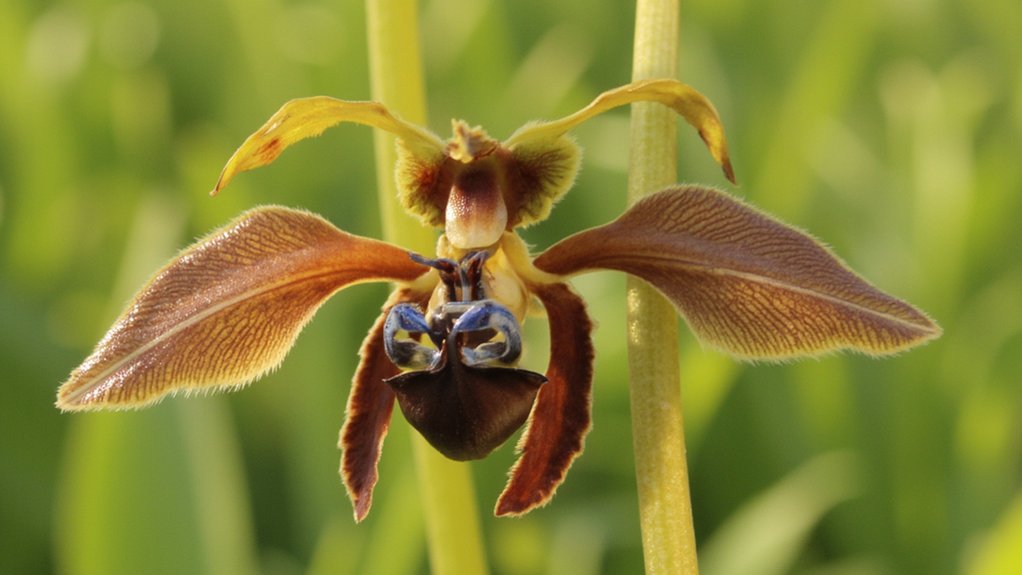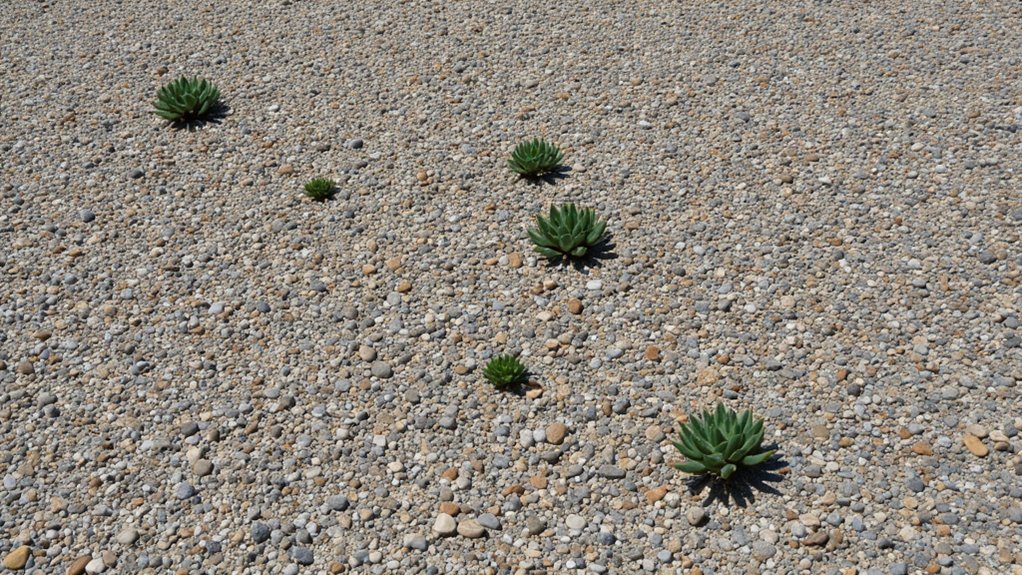You’ll find nature’s most skillful imposters hiding in plain sight throughout Earth’s diverse ecosystems. From orchids that perfectly mimic female insects to attract pollinators, to living stones that blend seamlessly with their rocky surroundings, plant mimicry takes countless fascinating forms. These botanical masters of deception have evolved their tricks over millions of years, employing strategies that’ll make you question what’s real in your garden.
Contents
The Science Behind Plant Mimicry

While many plants rely on vibrant colors or sweet nectar to survive, some species have evolved a fascinating alternative strategy – mimicry. They’ve developed physical features and chemical signatures that closely match other organisms, from insects to stones.
You’ll find that mimicry occurs through gradual genetic changes over thousands of generations. When random mutations create similarities to other species, these traits get passed down if they help the plant survive. The process, called convergent evolution, can affect a plant’s leaves, flowers, or even its scent.
Scientists have identified three main types: defensive mimicry, reproductive mimicry, and competitive mimicry.
Orchids: Masters of Insect Deception

Among all plant species that engage in mimicry, orchids stand out as nature’s most skilled deceivers. You’ll find that these clever plants have mastered the art of visual and chemical trickery to guarantee their survival.
Consider the mirror orchid, which produces flowers that look exactly like female wasps, down to the metallic sheen and fake pheromones. When male wasps attempt to mate with these deceptive blooms, they’ll inadvertently collect and spread pollen.
The hammer orchid takes this further by creating a movable lip that swings like a trap door, physically flipping confused male wasps onto the flower’s reproductive parts. It’s nature’s version of a carnival ride gone strategic.
Living Stones: The Art of Camouflage

Unlike orchids that mimic insects, some plants have perfected the art of disappearing into their surroundings. The Lithops, commonly known as living stones, are masters of camouflage, blending seamlessly into South Africa’s rocky landscapes.
You’ll find these remarkable succulents growing just 0.5-1.5 inches above ground, with only their split, rounded leaves visible. Their mottled, granite-like surfaces match the colors and patterns of nearby rocks so precisely that you’d need to look twice to spot them.
During drought, they’ll shrink below ground level, leaving just their translucent leaf tips exposed to capture sunlight while staying hidden from hungry herbivores.
Predatory Plants in Disguise
Just as nature’s most skilled hunters use stealth and deception, predatory plants employ remarkable disguises to trap their prey. You’ll find the pitcher plant masquerading as a safe haven, with its nectar-lined rim and vibrant colors attracting unsuspecting insects to their doom.
The Venus flytrap, native to North Carolina’s coastal plains, mimics small flowers to lure prey. When you examine its modified leaves, you’ll notice trigger hairs that, when touched, snap the trap shut in less than 1/10th of a second.
The sundew’s glistening tentacles look like morning dew drops, but they’re actually sticky digestive enzymes that capture and dissolve insects.
Evolutionary Strategies and Survival Tactics
While survival through mimicry has evolved over millions of years, nature’s most successful imitators haven’t stopped perfecting their craft. You’ll find plants developing specialized adaptations, from modifying their leaf shapes to altering their chemical signatures, to maximize their chances of survival.
These clever copycats don’t just randomly evolve – they’re responding to specific environmental pressures. When you examine successful mimics, you’ll notice they’ve developed precise mechanisms that fool their intended targets 80-90% of the time. Some orchids, for instance, can alter their appearance within 3-4 generations to match new model species in their habitat.
Notable Examples Across Global Ecosystems
Plant mimicry flourishes across Earth’s diverse ecosystems, from steamy rainforests to arid deserts. You’ll find the Australian orchid Chiloglottis trapeziformis perfectly imitating female wasps, right down to producing the same pheromones. In South Africa’s grasslands, Passiflora flowers have evolved fake butterfly eggs to deter actual egg-laying.
You can spot Boquila trifoliolata vines in Chile’s temperate forests copying the exact leaf shapes, sizes, and colors of their host trees. Even more fascinating, you’ll notice how dead-nettle (Lamium album) mimics stinging nettle’s appearance but lacks the painful spines, fooling potential herbivores while remaining completely harmless to touch.
Conservation Challenges and Future Research
As research into mimetic plant species faces mounting challenges, scientists must race against habitat destruction and climate change to document these remarkable adaptations. You’ll find that many of these unique plants haven’t been fully studied yet, and some may disappear before we comprehend them.
Current conservation efforts focus on protecting entire ecosystems where mimetic plants thrive, but it’s not easy. You’re looking at complex relationships between the mimic, its model species, and their pollinators – if one falls, they all might suffer.
Future research needs to explore DNA sequencing and evolutionary pathways, helping us grasp how these deceptive strategies developed.
